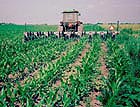Kitchen garden tips this week
It's time to harvest French, runner beans and courgettes regularly, prune cherries and lift up the onions says our gardening expert


Harvesting
Now that the kitchen garden is flourishing, pick French and runner beans regularly so that they’ll keep on producing more. For continuity of harvest, water copiously preferably with rainwater and, to retain soil moisture, mulch around the plants with grass cuttings. Courgettes also need to be harvested continuously to stop them developing into marrows. If you leave any growing on the plant, they, too, will stop further production. Leaf vegetables, such as wild rocket, perpetual spinach and cut-and-come-again lettuce, will put out fresh and tender new growth the more you cut them back. As you’ll have more than one plant, you can harvest the leaves in rotation.
Cherry trees
Whether they grow against the wall or as trained bushes, cherries can be pruned now they’ve finished fruiting; this will reduce growth and encourage new fruiting spurs. Cut strong upright stems as far down as a new lateral growth for a good crop next year. If your trees are susceptible to silver leaf or bacterial canker, you can combat this by pruning though the growing seasons of spring and summer, which will allow the tree to seal its own wounds. Any summer prunings can be shredded and used as mulch or put on the compost heap as an open layer between grass cuttings. A shredder is an excellent investment.
The onion harvest
Onions are ripening when the tops keel over while still green. It’s best to let them bend over by themselves rather than risk damaging the neck of the onion by forcing them over by hand. Last year’s wet weather shortened the onions’ growing season, as they need a dry July and August. Ideally, if they can grow on until August and have time to dry off naturally, you’ll have a better chance of storing them through the winter. Lift them when the foliage has turned brown and leave them on their sides to dry where you’ve dug them. Use a length of string to tie ,a simple knot around the neck of the onion and join up to 10 onions to a string. Then, make a loop at the top of the string and hang it up on a hook in a well-ventilated shed or greenhouse. The weight of the onions will keep the knots tight and you will quickly see any signs of rotting.
Shallots
Exquisite houses, the beauty of Nature, and how to get the most from your life, straight to your inbox.
They say that shallots should be planted on the shortest day and harvested on the longest. But it’s rare that conditions are suitable on December 21, except on the lightest of land. We start ours in pots so as not to lose too much time, and plant them out when conditions allow, and then, in a normal growing season, we see that the leaves are drooping by midsummer. By now, the foliage is brown and they’re ready to lift. Lay them out to dry and separate for storage in the same way as your onions by tying them in strings to be hung in an airy place. Any small shallots can be saved for next year’s crop.
Philip Maddison is head gardener at Harrington Hall, Lincolnshire (www.harringtonhallgardens.co.uk)
Country Life is unlike any other magazine: the only glossy weekly on the newsstand and the only magazine that has been guest-edited by His Majesty The King not once, but twice. It is a celebration of modern rural life and all its diverse joys and pleasures — that was first published in Queen Victoria's Diamond Jubilee year. Our eclectic mixture of witty and informative content — from the most up-to-date property news and commentary and a coveted glimpse inside some of the UK's best houses and gardens, to gardening, the arts and interior design, written by experts in their field — still cannot be found in print or online, anywhere else.
